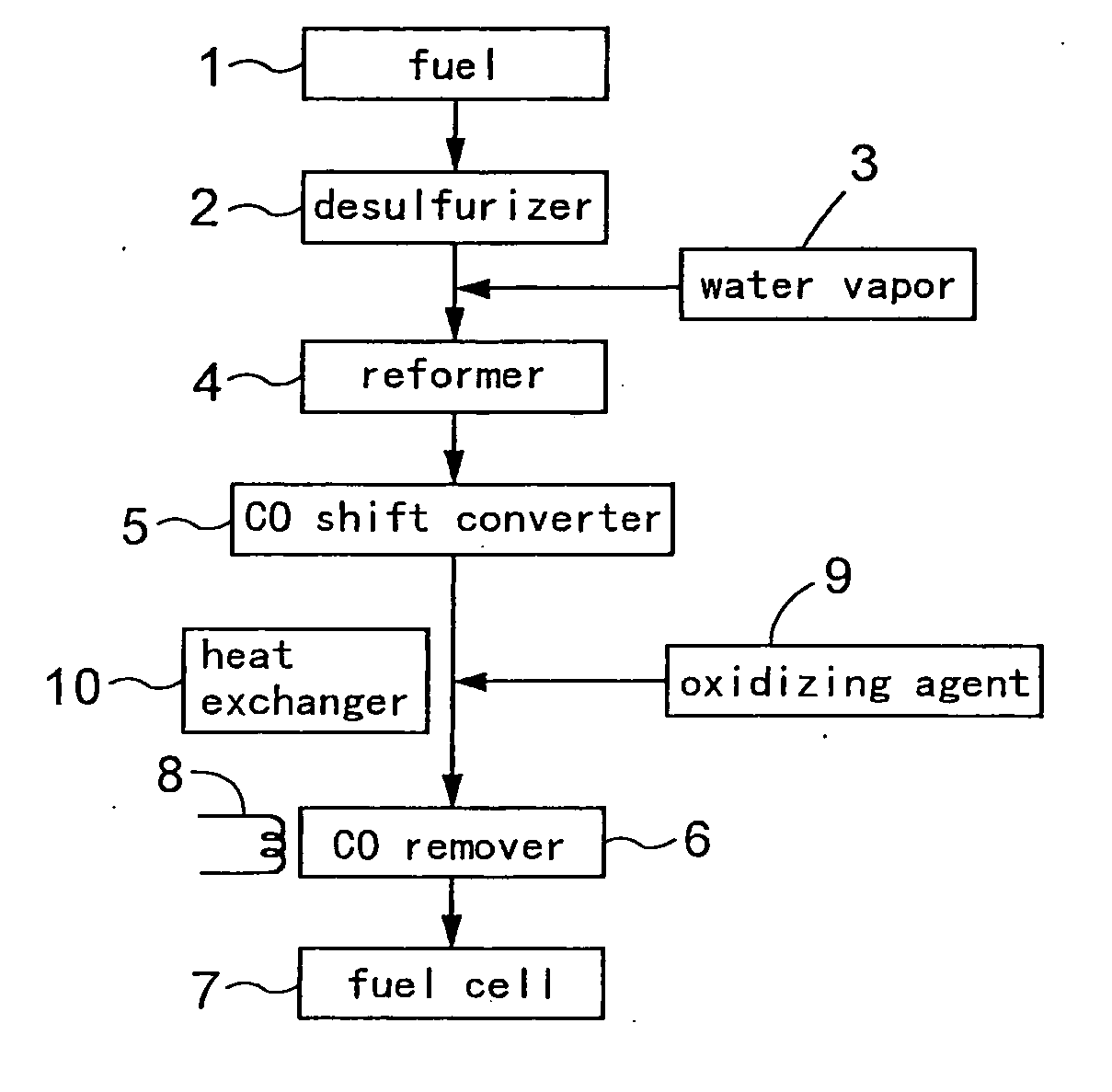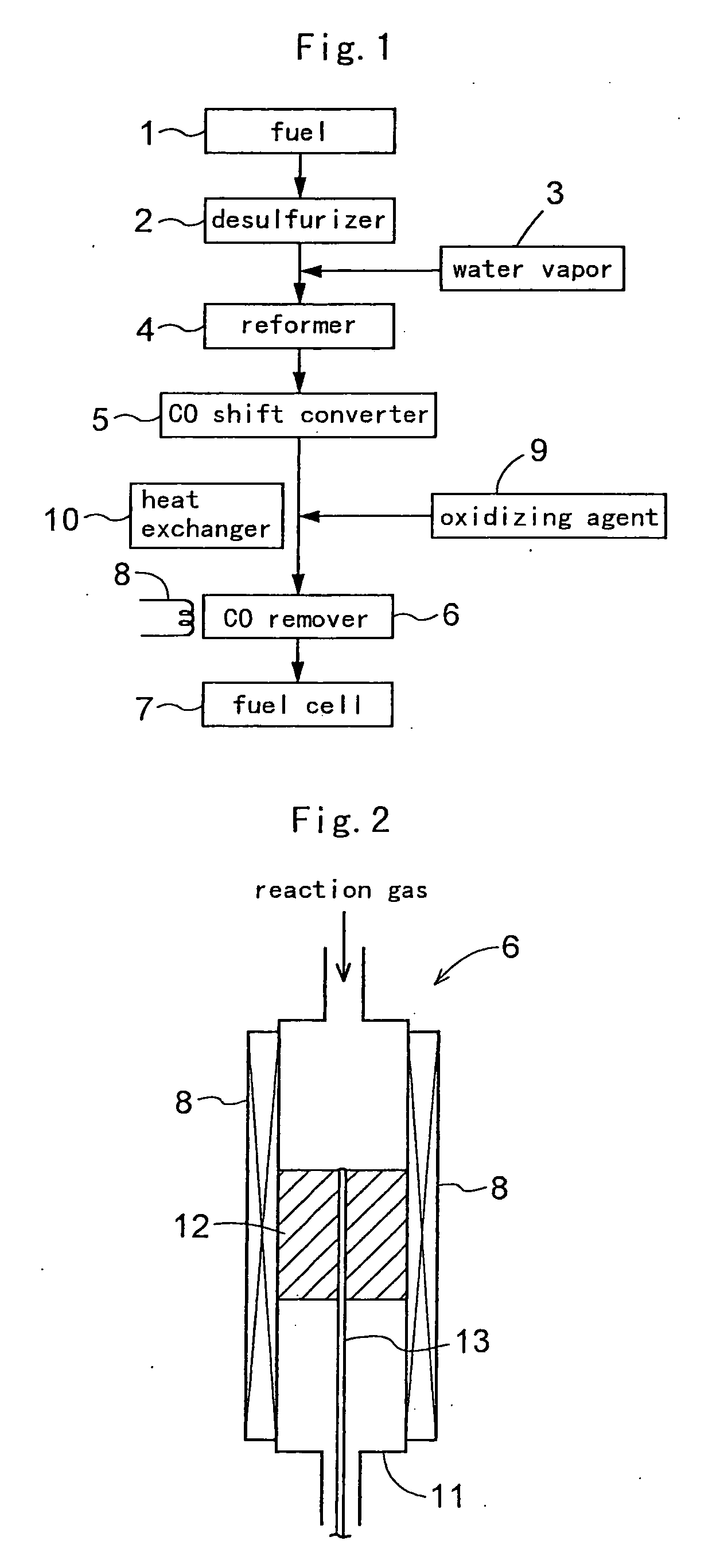Method of activating carbon monoxide removing catalyst, carbon monoxide removing catalyst, method of removing carbon monoxide and method of operating fuel cell system
a carbon monoxide removal and catalyst technology, applied in the field of carbon monoxide removal, can solve the problems of electrode catalyst poisoning, low activity, and need to add an excessive amount of oxidizer (oxygen) thereto, so as to reduce the initial activity of the carbon monoxide removal catalyst, reduce the loss of hydrogen, and reduce the effect of energy consumption
- Summary
- Abstract
- Description
- Claims
- Application Information
AI Technical Summary
Benefits of technology
Problems solved by technology
Method used
Image
Examples
example 1
[0093] As described hereinbefore, a carbon monoxide remover 6 was prepared by charging, into a stainless steel reaction tube 11, 8 cc of Ru / alumina catalyst (carbon monoxide removing catalyst) including a support of an alumina sphere of a diameter of 2 to 4 mm and ruthenium (Ru) supported on this support. This carbon monoxide remover 6 include a temperature adjusting means 8 having a heater capable of heating the reaction tube 11 from the outside and a cooler capable of cooling the tube, so that the temperature of the reaction tube 11 is controllable.
[0094] Then, while introducing the hydrogen-containing inactive gas (hydrogen: 6%, nitrogen: 94%) for activating the carbon monoxide removing catalyst at the flow rate of 1000 cc / min. to this carbon monoxide remover 6 (the ruthenium supporting amount of the carbon monoxide removing catalyst: 1.0 wt. %), the remover was heated by the temperature adjusting means until the reaction tube temperature reached 250° C. and was maintained at 25...
example 2
[0096] While introducing the hydrogen-containing inactive gas (hydrogen: 10 volume %, nitrogen: 90 volume %) for activating the carbon monoxide removing catalyst at the flow rate of 1000 cc / min. to the carbon monoxide remover 6 (1.0 wt. % for the ruthenium supporting amount of the carbon monoxide removing catalyst), the remover was heated by the temperature adjusting means until the reaction tube temperature reached 200° C. and was maintained at 200° C. for 2 hours (pre-treatment).
[0097] After this pre-treatment, the temperature of the reaction tube 11 was lowered to 110° C. and maintained at 110° C., and the simulated reaction gas was introduced into the reaction tube 11 at space velocity (GHSV): 7500 / h, thereby to allow an oxidizing removing reaction for carbon monoxide to take place. Incidentally, the simulated reaction gas employed was a gas having a composition (i.e. carbon monoxide: 0.5%, methane: 0.5%, carbon dioxide: 20.9%, oxygen: 0.8%, nitrogen: 3.1%, water (vapor): 20% a...
example 3
[0098] In this Example 3, by using the carbon monoxide remover 6 (0.5 wt. % for 15 the ruthenium supporting amount of the carbon monoxide removing catalyst), the pre-treatment was effected in the same manner as Example 2, except for setting the oxidation removal temperature for carbon monoxide to 120° C. FIG. 5 shows the exit (outlet) carbon monoxide concentration (determined by the gas chromatograph apparatus) obtained when the oxidation removal was effected in the above-described manner.
PUM
| Property | Measurement | Unit |
|---|---|---|
| temperature | aaaaa | aaaaa |
| temperature | aaaaa | aaaaa |
| temperature | aaaaa | aaaaa |
Abstract
Description
Claims
Application Information
 Login to View More
Login to View More - R&D
- Intellectual Property
- Life Sciences
- Materials
- Tech Scout
- Unparalleled Data Quality
- Higher Quality Content
- 60% Fewer Hallucinations
Browse by: Latest US Patents, China's latest patents, Technical Efficacy Thesaurus, Application Domain, Technology Topic, Popular Technical Reports.
© 2025 PatSnap. All rights reserved.Legal|Privacy policy|Modern Slavery Act Transparency Statement|Sitemap|About US| Contact US: help@patsnap.com



